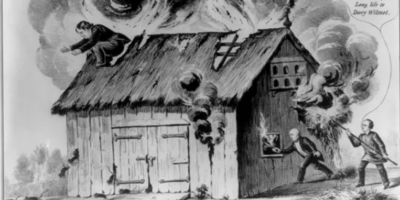From the Occupied Lexington Herald:
How we got here
By Austin Parker
By now, the bare facts of what happened in what’s commonly-known as the “Great Recession” are widely known. Unfortunately, these facts are little reported on by most media, here in Lexington as elsewhere. So in the interests of due journalistic diligence, here’s some information on what is meant when leaders refer to the housing bubble: how it happened, and how it contributes to our current depression economy.
The housing bubble
Colossal private banks, made even larger through decades of deregulation and lax oversight by the government-run Securities and Exchange Commission, pumped billions of dollars into the housing market worldwide. As they did, leading opinion makers (many of whom worked for, or were funded by the housing/banking industry) reinforced the need for Americans to by homes.
Then-president George W. Bush spoke of creating an “ownership society.” Then-Federal Reserve Chairman Alan Greenspan concurred. After the economy entered a recession following the 9/11 plane hijackings and the Enron financial scandal, Greenspan lowered national interest ratesto spur consumer borrowing and thereby grow the national economy. This was reflected in historically low mortgage rates, which spurred home-buying and refinancing of home loans. By 2004, Greenspan also publicly endorsed Americans’ growing reliance on sub-prime mortgages, mostly Adjustable Rate Mortgages (ARMS) whose interest rates (and mortgage payments) “adjusted” according to the Fed’s whims. In a speech that year to the Credit Union National Association, he claimed that such mortgages, which were higher risk and normally targeted to poor communities and people of color, provided Americans an innovative money-saving method to purchase a home.
Greenspan and Bush were just two of the most powerful and well-known American figures reinforcing the need for Americans to buy property at cut-rate deals. Real estate agents, bankers, mortgage brokers, media figures and politicians of every color all talked about houses as sound “investments,” brick and mortar bank accounts that contained equity (cash) that homeowners could use to pay for cars, vacations, braces, college or whatever else they desired. Bankers and mortgage brokers approved questionable loans. Cable networks followed marginally employed baristas as they received questionable loans and made bank on the enterprise known as home flipping: TLC’s “Property Ladder” and A&E’s “Flip this House” (not to be confused with TLC’s “Flip that House”) stand out here.
Two things happened when our media, politicians and certified experts told us to all buy homes, and when the financial services industry began to push alternate, more risky, methods for purchasing such homes. First, supply and demand: with demand stoked by fiscal, political and media outlets, housing prices soared throughout the 1990s and 2000s, pricing many people out of affordable homes. Second, Americans went increasingly into debt as they attempted to buy into the inflated market. Between 1990 and 2007, the ratio of debt to disposable personal income rose from 77% to 127%, much of this increase mortgage-related.
A popped housing bubble and a global depression
The dirty little secret, of course, is that bubbles eventually pop. Even the protestations of such economic luminaries as Alan Greenspan and every realtor between here and Boca Raton couldn’t stop the fact that this insane blood-pact of spiraling home values and risky mortgages would eventually wind up collapsing.
The banks, however, were smart. First, they divested themselves of the crappy mortgages they sold to unwitting home-buyers. They did this by packaging together large amounts of mortgages that were held on their books, and then selling them as a single “product.” Generally, these new products were referred to as derivatives because their value was “derived” from somewhere else—the ability of individual homeowners to pay the inflated loan values on the original mortgages. More specifically, the derivative products were known as “securities,” a term also used as a verb: Wall Street banks securitized their individual mortgages to be sold on the unregulated derivatives market.
The process of securitizing allowed banks to hide many of their bad loans. It also made it difficult for pension funds, individual retirement accounts, school boards, and others buying the securities as AAA rated investments, to understand what was contained in them. Alan Greenspan and most other financial wizards endorsed this practice as another modern financial innovation, though a slew of recent lawsuits against the banks more commonly cite it as white collar fraud.
After selling off their bad mortgages, banks then issued, purchased, traded, and otherwise mangled a new class of derivative financial instruments known as the CDS (credit default swaps), a fancy way of saying insurance. The colossal investment firms essentially bet the spread. If your home loans performed well (that is, if you did not default), banks stood to reap untold trillions off interest and fees on the loans. If your loans failed and crapped out the packaged securities sold to investors, banks could call in their “credit default swap” insurance policy. They won either way.
If this doesn’t sound absolutely insane to you, then you have a bright future in investment banking ahead of you.
The aftermath of the collapse of the housing bubble was a gut punch to the global economic system. As the banks started to unwind their books and revealed the depths of their exposure to subprime loans, the enormity of the crisis only became more in focus. At the height of the housing bubble, most banks were leveraging each dollar in deposits nearly ninety to one. (They had 1 real dollar for every 90 borrowed dollars.) The CDS market was valued over six times the value of the mortgage market in 2008.
Foreclosures soared. The recession led to employers cutting millions of jobs, and many of the new homebuyers saw their payments skyrocket as the rate on their ARM jumped. Refinancers and “flippers” were suddenly stuck owing thousands more than expected, or having a bundle of houses in their name, having been paying interest only on the properties without paying down principal. In many cases, people simply walked away from mortgages they couldn’t pay, which helped collapse the value of existing homes. These events have put tens of thousands of homeowners underwater on their home: the value of their home has sunk below the amount they still owe on their mortgage.
So, yeah, pretty bad stuff. Right?




Leave a Reply